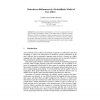Free Online Productivity Tools
i2Speak
i2Symbol
i2OCR
iTex2Img
iWeb2Print
iWeb2Shot
i2Type
iPdf2Split
iPdf2Merge
i2Bopomofo
i2Arabic
i2Style
i2Image
i2PDF
iLatex2Rtf
Sci2ools
106
click to vote
UM
2005
Springer
2005
Springer
Data-Driven Refinement of a Probabilistic Model of User Affect
We present further developments in our work on using data from real users to build a probabilistic model of user affect based on Dynamic Bayesian Networks (DBNs) and designed to detect multiple emotions. We present analysis and solutions for inaccuracies identified by a previous evaluation; refining the model’s appraisals of events to reflect more closely those of real users. Our findings lead us to challenge previously made assumptions and produce insights into directions for further improvement.
Related Content
| Added | 28 Jun 2010 |
| Updated | 28 Jun 2010 |
| Type | Conference |
| Year | 2005 |
| Where | UM |
| Authors | Cristina Conati, Heather Maclaren |
Comments (0)

